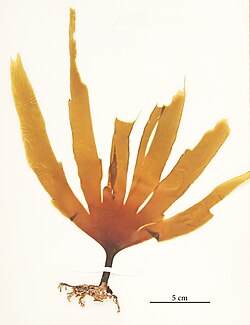Biology:Laminaria ochroleuca
| Laminaria ochroleuca | |
|---|---|
| Scientific classification | |
| Domain: | Eukaryota |
| Clade: | Diaphoretickes |
| Clade: | SAR |
| Clade: | Stramenopiles |
| Phylum: | Gyrista |
| Subphylum: | Ochrophytina |
| Class: | Phaeophyceae |
| Order: | Laminariales |
| Family: | Laminariaceae |
| Genus: | Laminaria |
| Species: | L. ochroleuca
|
| Binomial name | |
| Laminaria ochroleuca Bachelot de la Pylaie, 1824
| |
Laminaria ochroleuca is a large kelp, an alga in the order Laminariales.[1] They are commonly known as golden kelp, due to their blade colouration, distinguishing them from Laminaria hyperborea[2]
Description
This large brown alga can grow to a length of 2 m. It has large leathery blades or fronds which grow from a stipe. The blade is without a midrib and divided into smooth linear sections. The stipe is stalk-like, stiff, smooth and attached to rocks by a claw-like holdfast.[1] It is similar to Laminaria hyperborea but it is more yellow in colour[3] and does not have the rough stipe of L. hyperborea.[1]
Despite initial belief that the species was declining, investigations in 2022 and 2023 displayed recent growth and abundance of new individuals.[4] It is suspected, however, that due to climate change, the range of Laminaria ochroleuca will shift north.[5] The ideal temperature for the sporophyte phase is 12-22 °C, while the gametophyte has a narrower range of 15-18 °C.[6]
Reproduction
The life-cycle is of the large diploid sporophyte alternating with the microscopic haploid stages producing female gametophytes which are fertilized by male gametophytes (sperm).[1]
Distribution
This species is found in the Northern Hemisphere, from Morocco to the south of England [7] In the UK, it was first documented in Plymouth Sound in 1946 [8] and its range expansion continues due to climate change.[9] It was found on the northeast coast of England beyond the Humber estuary before 1965.
Bioactive Compounds
Laminaria ochroleuca has been shown to possess antimicrobial and antioxidant qualities, as well as a valuable source of nutrition.[10][11] Actinobacteria strains isolated from Laminaria ochroleuca also revealed anticancer capabilities.[12]
References
- ↑ 1.0 1.1 1.2 1.3 Bunker, F.StP,D., Brodie, J.A., Maggs, C.A. and Bunker, A.R. 2017. Seaweeds of Britain and Ireland. Second Edition. Wild Nature Press, Plymouth, UK. ISBN:978-0-9955673-3-7
- ↑ Franco, João N.; Tuya, Fernando; Bertocci, Iacopo; Rodríguez, Laura; Martínez, Brezo; Sousa-Pinto, Isabel; Arenas, Francisco (2018). "The 'golden kelp' Laminaria ochroleuca under global change: Integrating multiple eco-physiological responses with species distribution models". Journal of Ecology 106 (1): 47–58. doi:10.1111/1365-2745.12810. Bibcode: 2018JEcol.106...47F.
- ↑ Hardy, F.G. and Guiry, M.D. 2003. A Check-list and Atlas of the Seaweeds of Britain and Ireland. British Phycological Society, London. ISBN:0-9527115-16
- ↑ Giacobbe, Salvatore; Ratti, Simona (2023-07-18). "Unexpected recovery of Laminaria ochroleuca in the Strait of Messina" (in en). Marine Biodiversity 53 (4): 54. doi:10.1007/s12526-023-01356-x. ISSN 1867-1624. Bibcode: 2023MarBd..53...54G. https://doi.org/10.1007/s12526-023-01356-x.
- ↑ Pereira, Tânia R.; Engelen, Aschwin H.; Pearson, Gareth A.; Valero, Myriam; Serrão, Ester A. (March 2017). "Population dynamics of temperate kelp forests near their low-latitude limit" (in en). Aquatic Botany 139: 8–18. doi:10.1016/j.aquabot.2017.02.006. https://linkinghub.elsevier.com/retrieve/pii/S0304377017300505.
- ↑ Schoenrock, Kathryn M.; O’Callaghan, Tony; O’Callaghan, Rory; Krueger-Hadfield, Stacy A. (2019-06-13). "First record of Laminaria ochroleuca Bachelot de la Pylaie in Ireland in Béal an Mhuirthead, county Mayo". Marine Biodiversity Records 12 (1): 9. doi:10.1186/s41200-019-0168-3. ISSN 1755-2672. Bibcode: 2019MBdR...12....9S.
- ↑ Smale, Dan A.; Wernberg, Thomas; Yunnie, Anna L. E.; Vance, Thomas (2015). "The rise of Laminaria ochroleuca in the Western English Channel (UK) and comparisons with its competitor and assemblage dominant Laminaria hyperborea". Marine Ecology 36 (4): 1033–1044. doi:10.1111/maec.12199. Bibcode: 2015MarEc..36.1033S.
- ↑ Parke, Mary (1948). "Laminaria ochroleuca de la Pylaie Growing on the Coast of Britain". Nature 162 (4112): 295–296. doi:10.1038/162295c0. PMID 18934880. Bibcode: 1948Natur.162..295P.
- ↑ Pereira, Tânia R.; Engelen, Aschwin H.; Pearson, Gareth A.; Valero, Myriam; Serrão, Ester A. (2017). "Population dynamics of temperate kelp forests near their low-latitude limit" (in en). Aquatic Botany 139: 8–18. doi:10.1016/j.aquabot.2017.02.006. https://linkinghub.elsevier.com/retrieve/pii/S0304377017300505.
- ↑ Flórez-Fernández, Noelia; Torres, María Dolores; González-Muñoz, María Jesús; Domínguez, Herminia (March 2019). "Recovery of bioactive and gelling extracts from edible brown seaweed Laminaria ochroleuca by non-isothermal autohydrolysis" (in en). Food Chemistry 277: 353–361. doi:10.1016/j.foodchem.2018.10.096. PMID 30502157. https://linkinghub.elsevier.com/retrieve/pii/S0308814618318715.
- ↑ Silva, Aurora; Rodrigues, Carla; Garcia-Oliveira, Paula; Lourenço-Lopes, Catarina; Silva, Sofia A.; Garcia-Perez, Pascual; Carvalho, Ana P.; Domingues, Valentina F. et al. (2021-08-18). "Screening of Bioactive Properties in Brown Algae from the Northwest Iberian Peninsula" (in en). Foods 10 (8): 1915. doi:10.3390/foods10081915. ISSN 2304-8158. PMID 34441692.
- ↑ Girão, Mariana; Ribeiro, Inês; Ribeiro, Tiago; Azevedo, Isabel C.; Pereira, Filipe; Urbatzka, Ralph; Leão, Pedro N.; Carvalho, Maria F. (2019). "Actinobacteria Isolated From Laminaria ochroleuca: A Source of New Bioactive Compounds". Frontiers in Microbiology 10: 683. doi:10.3389/fmicb.2019.00683. ISSN 1664-302X. PMID 31024480.
Wikidata ☰ Q12236931 entry
 |



